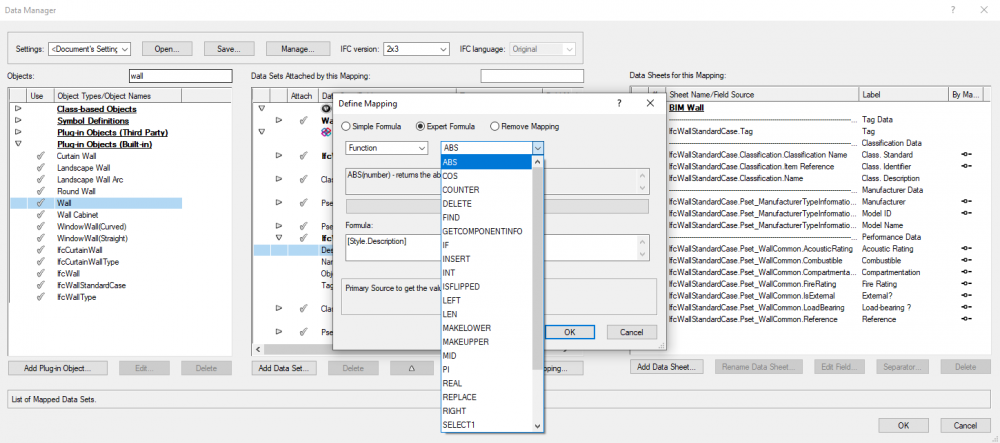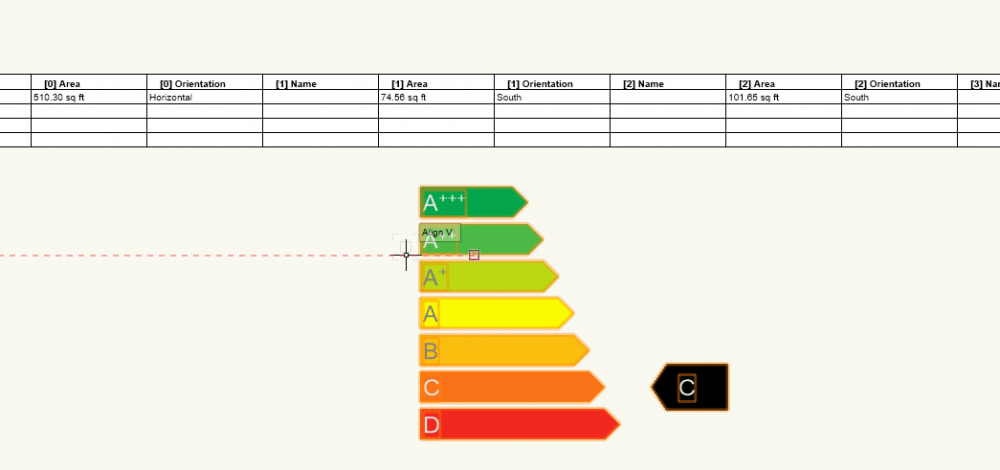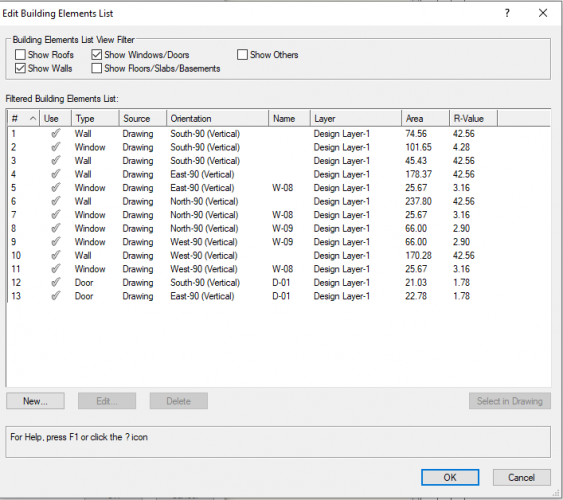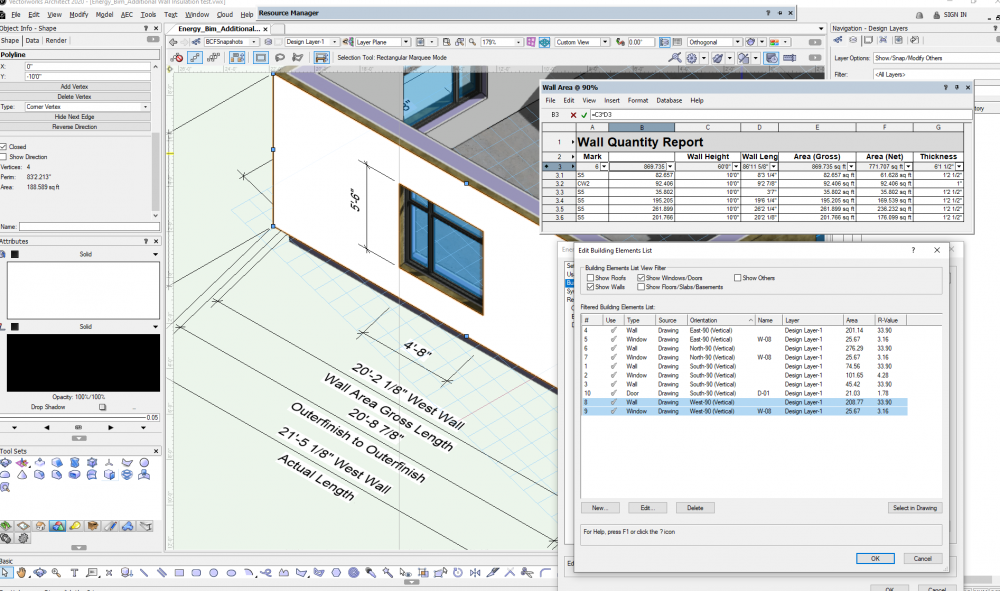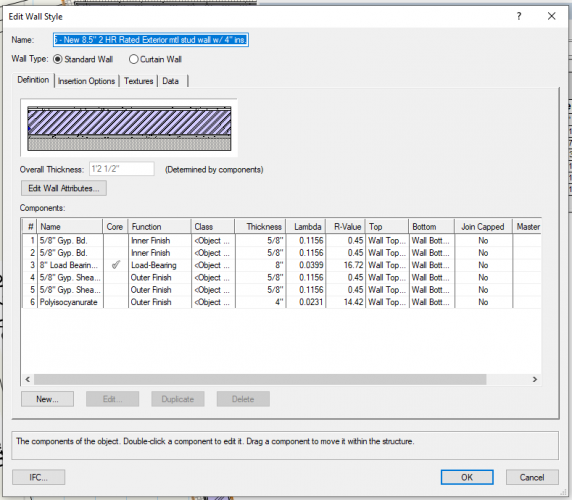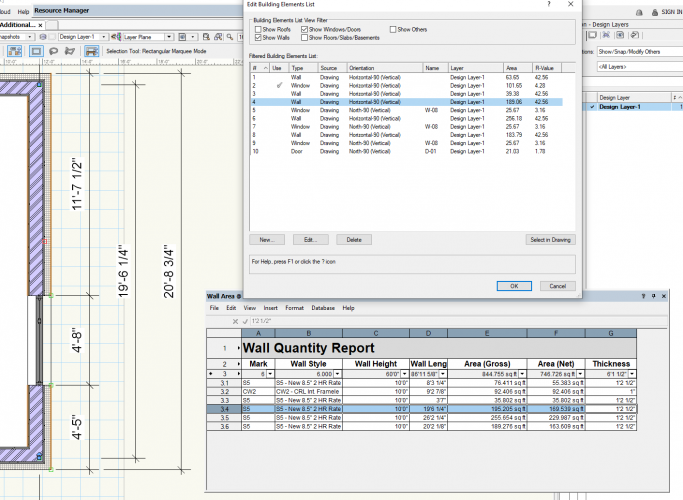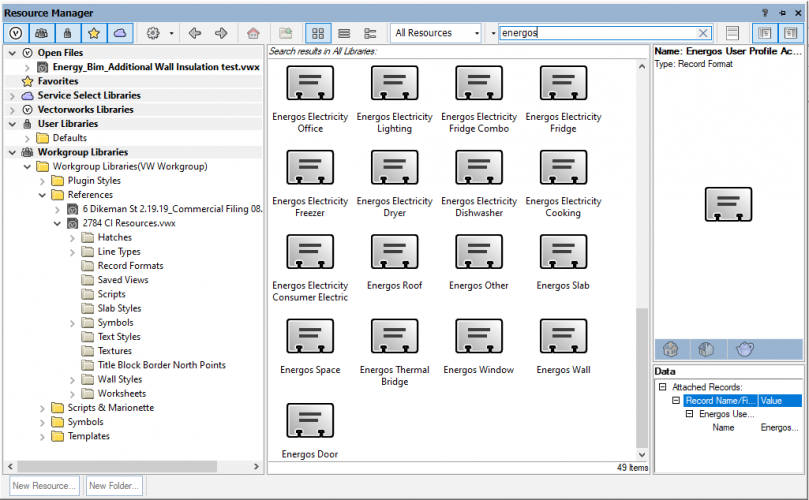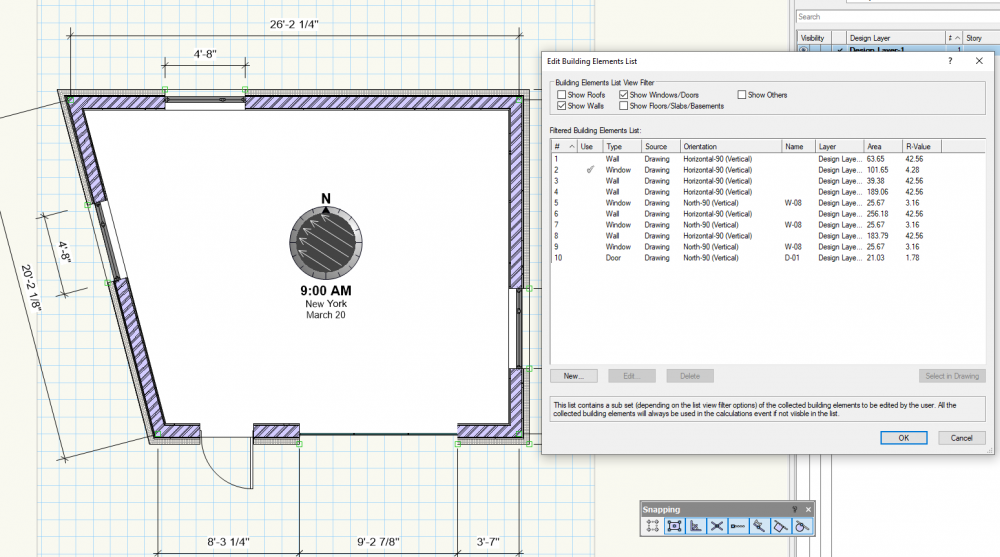
Samuel Derenboim
Member-
Posts
472 -
Joined
-
Last visited
Content Type
Profiles
Forums
Events
Articles
Marionette
Store
Everything posted by Samuel Derenboim
-
Hi everybody, The functions like #ΔY#, #ΔX# or #ΔZ# can be used for polygons to callout rough dimensions of polygons via the data tag tool. I can't seem to be able to find it in the worksheet functions. do they exist? Functions like length width and height cannot be called out if the polygon has punch outs, and only these functions will call out the proper information. Thank you in advance.
-
Thank you @Luka Stefanovic , I agree with most of what you say, doing energy calculations, one has to be extremely tedious and meticulous with the conveyed information in the worksheet. If you want to work for only the client - this would be enough. If you need to present this information to local building department and zoning ordinance (in my case - New York) the information has to be verifiable (this ultimately tests the tools legitimacy to the building department) Since Energos only provides summed areas and no charts or worksheets to sum up wall UA averages between every cardinal axis,I've since needed to use the information directly from plugin objects to display in a worksheet, rather than using energos directly. I do not know if it is a requirement in other states, but in New York, i can definitely attest to the fact that tabular approaches to spaces, wall areas and U values are required. In fact, it is something i am working on as we speak. This only came up now because I am working on a project that attempts to implement the same rules I've used below. My solution to the problem is a separate matter. After having tested energos first hand i wasn't able to extract several things. (look through the earlier message board to see some of the attachments i've provided as a resource...otherwise i can send them to you directly if you wish). The things spoken about in this thread that cannot be extracted directly was the biggest area of concern. 1. Exterior surface area (Like Energos does) - you've commented on this, and you are accurate in your description. If you have another way of extracting it, would love to hear it. 2. Orientation of the walls in reference to Cardinal Axis (like Energos does). As far as I know, and @Nikolay Zhelyazkov mentioned, only the energos label tool can do it. If you can extract it without the tool, would love to utilize that feature as well! 3. Length of exterior surface area (inside wall length and outside wall length cannot be obtained, only the center line of the wall). Can be deduced if you divide surface area by the grosswallheight. but it goes back to problem 1 above. 3a. There is a trick you can use in order to calculate pure exterior wall surface area. By using an additional component in the wall, you can make the component thickness .001 inches or something similar. That way when you calculate ComponentArea in this case, it will return the area of that component (net area at least), and length can be deduced from it as well. Problem is, using the component area trick - only works on solid walls - it does not work on curtain walls. 4. Since all wall lengths are calculated from the center of the wall, any walls connected to other walls (L connection) must add wall thickness in order to get the pure exterior surface. Full wall thickness is added to a wall connected on both sides, half wall thickness is added to walls connected to only one side. Unfortunately, there is no function in worksheets that can be inserted to check for walls joined in L mode, nor is it possible to check if it is connected on only one side or on both sides of the wall. Had there been such a worksheet function, this problem can possibly be solved using a conditional =if() statement for both Lengths, and by extension, net wall surface area for both curtain walls and solid walls. 5. Corner windows are also measured differently, they can end up having a different measured length from the outside than the computed length provided in the PIO. (needs to be dimensionally verifiable for the building department). This is the same center line problem as the walls. 6. In order to get information that's taken from energos, record information can be extracted from the label tool. This includes cardinal axis and exterior surface area. (problem 2) It is possible to extract but it is modifiable - not like parameters PIO like walls, windows, doors, etc... can be computed through functions like area, length, etc... that end up being greyed out. Additionally, energos creates a separate record for every object that in the document. If every object has a separate record, it would be impossible to document or extract properly or conveniently. This was the basis and the crux of my criticism. Thank you again for looking into this. As far as I know, very few, if not, no other software company listens to the user posts and concerns. Your team has addressed many concerns in the past of this forums wishes, and I am personally grateful for it.
-
@Luka Stefanovic Thank you for your reply. I agree, that it is a useful to evaluate the information when you are designing, however, These calculations can be reiterated just by using worksheets as well. Much of the information that energos shows goes through an additional plugin object that doesn't necessarily work the parametric aspects of the model itself. This is something I ran into when trying to get gross wall areas and net wall areas from curtainwalls and regular walls. I think that is a severe limitation because you cannot extract certain information from energos like exterior wall surface area, interior wall surface area, etc... What energos does instead it takes a one time extraction of the plugin objects and copies that information into a the label plugin object making it much more cumbersome to verify the information that it calculates. It would be easier to extract the information in realtime just like a worksheet does from any plugin object, that way any information energos uses can be extracted into custom worksheets. Just some food for thought 🙂 Regarding much of the information from space objects that A Mcdonal mentioned can be cleverly manipulated without having to enter energos information, but rather extracting information from a separate record and combining it with space objects with plumbing or heating records. If information matches, it calculates demand temperatures for those particular areas. It is something I plan on integrating in the future of my workflows. But as it stands, Energos still doesn't display the surface area of wall and curtainwall objects correctly, no does it display the areas for corner windows correctly (this is a bug that was submitted) that prohibit accurate results. As a reference, I used grosswallarea_net versus Component net area and it had a difference of 6 - 8% fenestration area percentage with the same geometry using windows, corner windows and curtainwalls as fenestration objects. 6-8% can be a very large difference between heat loss / gain, and consequentially, a substantial impact on mechanical system requirements.
-
There is a way to convert revit models into vectorworks, but it does involve quite a few steps. Bottom line is, there is a method to import an entire directory worth of revit models into VW and then modify them one by one unfortunately.
-
Would something like that be in demand?
-
Thank you @Pat Stanford Just a follow up question if this is true, why would something like heights and width for a door or window be shown in their respective ifc records ?(will double check on area, but i think its there) and why would addition, substraction, multiplication or division be shown as part of some of the tools in the advanced settings tab?
-
Hi Everyone, Is it possible to assign dimensional properties of a wall, curtainwall, etc... to IFCWallStandardCase.BaseQuantities using the expert formula function? I can't seem to be able to find WallArea_Gross or WallArea_Net under object properties like I would in the worksheet object properties. Can something like this be done?
-
Thank you, will do.
-
@Nikolay Zhelyazkov Thank you again for your input. Just some notes if you are to help design a (perhaps) for reliable system for energy performance modeling.... In terms of the element ID, I think youre right. Seems that the numbers displayed in the elements list display the information for that particular row. For me there are two problems with that. Notwithstanding the surface area math and corner window improper area calculations, one would need to create a separate table column for every element ID in energos in the hopes that it will return the proper information. I suppose one could use a conditional statement along with a concat callout referencing a +1 sum starting from element 1 to try to display all of the fields, but it seems certainly counterintuitive. Only yesterday i learned of the concat command and how useful it can be. The second problem that i see is that the energos label records the information one time, and prints it out as editable text rather than something that's directly related to the wall , window, door etc. (correct me if I'm wrong, but the worksheet you sent showed the text as editable, therefor it wasn't a constrained record directly relating to a wall, window, etc...). the problem with that is it opens up potential user error should a user update the plan, but not the energos label. I also don't understand why energos does not record the wall, floor or roof type name in the name field along with doors and windows. Seems strange to me that it doesn't identify which walls are which should the situation arise that there are multiple wall types in one orientation. It also does not record the story on which the walls, slabs, windows or doors are located. The only clue you might get is the R value. I spoke to a representative yesterday regarding this issue because i had a separate problem from this one, but since energos came up in our conversation, i sent a sample file showing my attempt at getting live information from walls, curtainwalls, windows and doors. That will be the information I use for the local zoning ordinance for a tabular approach. Hope it helps. Thanks again.
-
PIO object - detach record bug
Samuel Derenboim replied to Samuel Derenboim's question in Troubleshooting
Pat, thank you again, i called support, and solved the problem. For anyone out there that has the same problem, it mightve been caused while upgrading to 3.1 Solution is : Vectorworks preferences - > Session Tab -> Reset Saved Settings -
PIO object - detach record bug
Samuel Derenboim replied to Samuel Derenboim's question in Troubleshooting
Thank you Pat, That's strange. I have VW2020 SP 3.1 as well, and it does not delete using the same method. Just in case, we're not talking about deleting the record from the resource manager, right? edit. Did hard reset, reset plugin objects and reset data manager. Still no luck ... -
I did do that. I got a single row returned for the south wall, without any understanding of the representation of the areas - which are windows, which are doors, or walls, etc... Here is actual building element list from PIO
-
@Nikolay Zhelyazkov Hm, I tried that. for some reason i can't get it to work. Also, since you submitted a bug report, just wanted to let you know, the areas for corner windows are inaccurate as well. If you take a look at a corner window - Dimensions are 6'5 1/8" x 5'6 (they are measured in the window PIO as 6'-0" by 5'6). In either situation, they do not amount to 66 s.f.
-
Good morning everyone, I've attached a record to a PIO, but cant seem to detach it afterwards. Uploading the file for verification. Can anyone confirm this is a bug? or could it be my settings? DetachRecord Bug.vwx
-
@Nikolay Zhelyazkov Thank you! I inserted the worksheet into the drawing, but its not returning any information. Is there something in particular i need to add?
-
Good Morning @Nikolay Zhelyazkov , Thank you for your help. 1. I've taken a look at the Energos label settings, and i noticed that it has some of the information, but I do not know how to extract it into the worksheets, namely Areas or orientation. I've added a space to the test drawing and it deduces North, East, West, South correctly, but getting that data out is the hardest part. Do you have a string or formula that I can enter to get area and orientation information for walls, windows, slabs, etc... in a worksheet? 2. I'm attaching the test drawing with the data sheets inside. Compare the areas inside, they do not unfortunately calculate the outer wall area surface, or the net area. I'm not sure what they're calculating as the areas are off by 4-6 s.f. each. Here is an example screenshot for reference. Energy_Bim_Additional Wall Insulation test_Forum.vwx So in the screen shot are three windows that are important - 1 - energos building elements list, 2 - a worksheet that extracts wall area lengths, gross areas and net areas, and three, the extraction of geometry from the wall itself to calculate the true surface area. The west wall surface is extracted as 208.77 s.f. (not sure if this is gross or net) however, either the way the calculation doesn't work. Lets say for argument sake it is net. We have one window on that wall that is 25.67 s.f. in area. The actual wall height is 10'-0" by 21'5 1/8". The core is placed at the center of the stud side. 208.77 + 25.67 = 234.44 s.f. / 10' height = 23.44 foot length. Actual wall length is 21'5 1/8". The area seems closest to sheet rock side (noted as 20'8 7/8" length x 10'-0" = 209 s.f. +-. I don't know why it doesn't calculate the outer surface area. See below for screen shot of wall style properties. (note: changing the insulation from outer finish to insulation doesn't change the area) If I extract the surface of the wall, I get 188.589 s.f. (net) + 25.67 s.f. window = 214.259 s.f. / 10'-0 Wall height = 21.4259 ft length or 21' 5.11" which is the correct length. This is not to say that the gross area and the length of the wall in the worksheet are grossly different - 20' 2 1/8" Length, and Area being 201.766 s.f, but at least I understand how Vectorworks PIO is getting that information. Thank you for your consideration and help once again.
-
@Nikolay Zhelyazkov it seems you're right, energos has a different outer wall area, see below. My question is - how do i call out Energos version of the wall area & wall length? It seems that energos record can only be called out once the record is inside of the file. However, either way, even if i did want to call out it via IFC, there is no information that is see that i can reference the information shown in the Energos Project settings building Elements list. Perhaps there is something I am unaware of? Attached is a screen shot of energos wall record in IFCWallStandardCase. The information regarding Area, Uvalue, orientation, etc... is not filled in or referenced - which is why i wanted to somehow fix it using the DataManager
-
1. Wall thickness isn't as important on the diagramatic drawings as areas area, thats the reason why i was curious, I will post this on the wish list as you mention. Thank you 2. Energos records are in the resource manager library - see image below. What i want is to link the wall areas, location and u values using the data manager to the attached record. Is this possible? 3. How do you reference the open side of the wall areas ? Compareabyname ? or is there another method? Something to note, length and area are only different on the open side of the wall if it has a corner connection that are joined in wall connection L mode. To get the outer areas only in that condition, one would need to specify the ( wall thickness + wall length ) * Height in order to get the outer area otherwise walloverallheight and =Length work. (Is there a conditional statement to callout L joined mode to calculate outer areas / dimensions?) i.e. - if ((insert condition of wall connected in L mode), Walloverallarea + (wallthickness*Walloverallheight), Walloverallarea) 4. Same question applies to length - how do i reference length of open areas of wall? It will be different than the actual length of the wall? Note - same condition would apply to the application of length in outer areas - Outerlength in L joined mode = Length+wallthickness 5. Is there a list of what the numbers mean? and how do i update the locations of the walls? do i move the holeidon tool in reference to those walls? Some of them do not match in terms of north, east, south, west, etc... See below
-
Hi @Nikolay Zhelyazkov, 1. Will functions like WALLAREA_GROSS, WALLAREA_NET, WALLTHICKNESS be added to tags? I thought about simply adding an energos record to a wall, but it does not fill in the properties set therein for U values, Gross areas, net areas, etc... is there a way to do this? (that would be my work around for using the information) The reason i need to call out these areas are for energy requirements reviewed at the local building department (NYC) and WallArea_NET or WallArea_Gross (that can be called out in worksheets) does not exist in the tag tool. I need to somehow show it in plan or elevation for clarity, and then calculation the UA averages for say, southern walls, northern walls, etc...per floor 2. why create a separate energos label if windows, walls, floors and the like can be linked to energos via their properties? 3. Is there a reason why energy calculations and dimensional measurements for wall areas are calculated based on centerline of wall? 4. How do you call out energos wall orientation for a wall, window, door or curtainwall without manually attaching the energos record to the object? 5. When some objects are called out via orientation, they are represented by numbers. How does one translate it to South, North, East, West etc...? Is there a way to set these parameters in the Data manager?
-
Hi Everyone, Just curious, wanted to get a consensus on the forum, are there many here that use Vectorworks parametric capabilities to do zoning analysis and building code analysis as a tabulated resource? or do people generally do them by hand? The reason I'm asking this question is because the tools vectorworks provides, seem to me, are unlike any other in terms of the tools provided for custom parametric integration (i.e. custom records/fields via simple geometry or the like). I have been using these features for zoning, building code and energy code independently for the past 3 years, and i have found alot of benefits as well as a few difficulties in using systemic parametric integration for code or zoning analysis. For example, one of the difficulties i've faced is the way New York jurisdictions requires us to calculate zoning areas vs building code areas. Zoning areas, they ask us to provide area diagrams that are simple in geometry (i.e. squares, rectangles, trapezoids, etc..). If you have a few tenants, or many, rather than calculating each area and each space independently, one can use large geometric areas to describe a floor plate. I have used this for general zoning calculation. When analyzing for building code, however, it would be recommended to show every tenant space for analysis purposes. The building code isn't as closely monitored as zoning in terms of areas is in NYC, but they should be equal in area to avoid notice in deviations. Because larger buildings, especially with tenant build-outs can be asked by the client, having to separate building code analysis and zoning could prove to be tricky due to the different methods of analyzing the information simultaneously. That is the reason why I have separated them into separate area categories. Getting the floor plates to equal can sometimes be a pain because there can sometimes be elements that do not match, and troubleshooting the problems can be tedious. So I thought id bring up the question to the trusty vectorworks community, see if anyone else have found interesting techniques to perhaps marry the two components? Out of curiosity, has anyone tinkered with analyzing code and / or zoning using Vectorworks? what are you experiences like?
-
Totally agree with this. It is impossible to separate master BIM file with worksheet file referencing it for elevations, sections, etc.... even in plans it would be useful to callout doors, objects, windows, walls, etc...
-
Hi everyone, I noticed that the getlocation within a space name or space number works perfectly for any record that needs to be called out thats within a space. VW did a great first to show the space location for symbols located in a space....However, locating objects in space is half the battle until you need to calculate allowable wattage per room, or allowable illuminance, circuitry, or any information within a particular space entity. I noticed tags like =Getifcproperty() or =GetCOBieProperty(), but i don't know how to define them to call out areas. If it doesn't exist, would it be possible to include it in future generations of VW? Also, is it possible to do the same with basic geometry? i.e. getobjname, getobjproperty, etc.... ? Below is an example worksheet where i would need to show the location and area of the location. The location column uses=GETSPACENAMEFOROBJ, the next column would ideally show area - then i can say whether or not that space is in compliance for wattage allowance based on the energy code.
-
symbols in geometrical boundary count via tag
Samuel Derenboim replied to Samuel Derenboim's topic in Architecture
First Attempt. Procedure FillCountsRecord; Var H1 :Handle; H2 :Handle; LocName :String; LocName2 :String; RecName :String; RecName2 :String; FieldName :String; FieldName2 :String; CriteriaString :String; CriteriaString2 :String; S1 :String; S2 :String; TheCount :LongInt; Procedure Execute(H3:Handle); {This is the procedure called by the ForEachObject command} Begin SetRField(H2,RecName,FieldName)); SetRField(H1,RecName2,FieldName)); {Store the count in the record} End; Begin H1:=FSActLayer; LocName:=GetName(H1); If ((H1<>Nil) & (H2<>Nil) & (LocName<>'') & (LocName2<>'')) then Begin RecName:='!Ltlegend'; {Enter the Record Name you want to store} SetRecord(H1, RecName); FieldName:='Zone'; RecName2:='!Lights'; {Enter the Record2 Name you want write to} SetRecord(H2, RecName); FieldName:='LZone'; CriteriaString1:='(((R IN ['!LtLegend']) & (ALL)))'; {Us the Criteria builder to generate the criteria string you want and store here} CriteriaString2:='(((R IN ['!Lights']) & (T=SYMBOL)))'; {Do not include the LOC criteria as that is defined by the named object} {selected when the script is run} S1:=Concat('((LOC=', LocName, ') & ', CriteriaString, ')'); {Do not change this line, only change Criteria String} ForEachObject(Execute,S1); S2:=Concat('((LOC=', LocName, ') & ', CriteriaString, ')'); ForEachObject(Execute,S2); End Else AlrtDialog('Something went wrong. Either no object was selected or the LOC object was not named in the OIP.'); SetDSelect(H1); {Forces Refresh of OIP} SetSelect(H1); SetDSelect(H2); {Forces Refresh of OIP} SetSelect(H2); {Resets to original selection state} End; Run(FillCountsRecord); -
symbols in geometrical boundary count via tag
Samuel Derenboim replied to Samuel Derenboim's topic in Architecture
Wow, this is beautiful. Works like a charm. In order for this script to have integrated information, it would be easier to simply copy the zone information in an attached record from the boundary onto all symbols in that zone rather than counting the objects. That way, i know if the zone matches between the objects and the zone itself, they could be aligned in the worksheet easily and specify any required specific information about that zone (like wattage, lumens, etc..) there was a script you wrote once regarding counting the number of people in a space object by using the space object area and dividing it by a separate record. maybe that can give me a hint as to how to take information from one record and copy it to all the objects (or symbols) with the LOC of the boundary.



